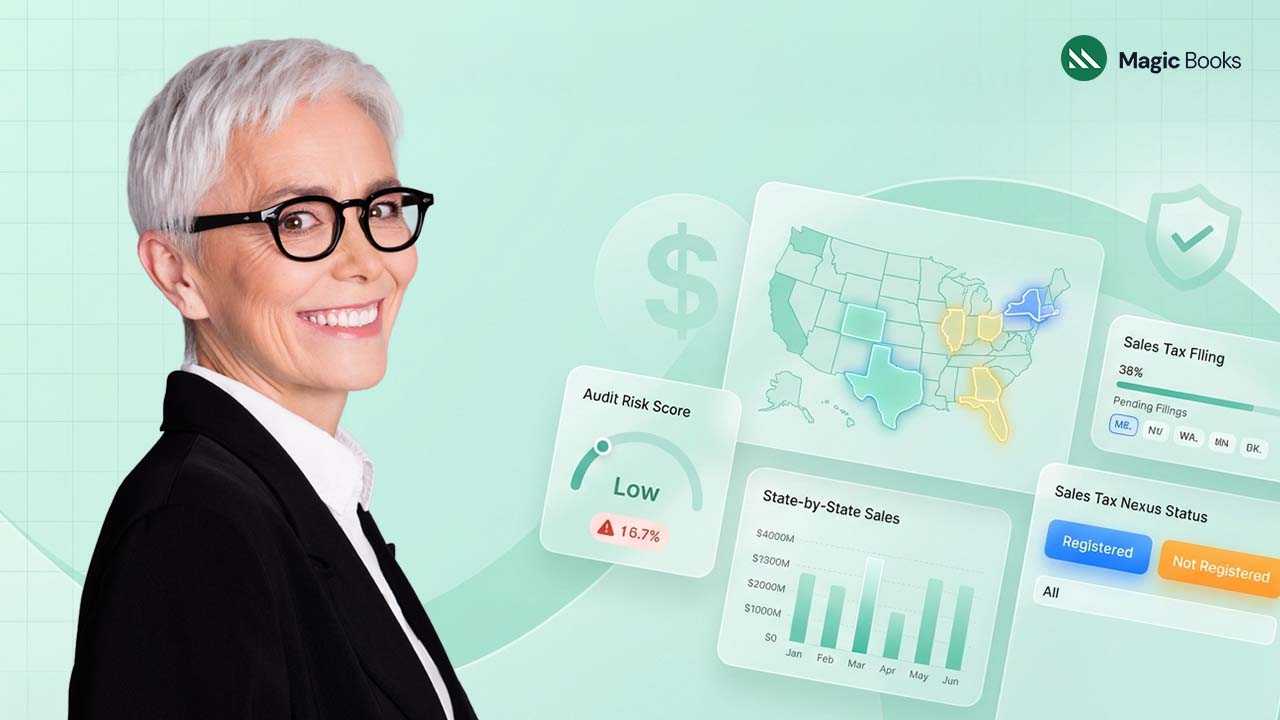What if we told you that the secret to success in your business wasn’t locked away in winning more clients or launching new products, but something so much less glamorous – an 8-step process that will either make or break your financial future? The truth is: we are talking about the accounting cycle. Now, it sounds exciting, right? This structured process is the heartbeat of your business’s financial health. Without this, you essentially are flying in the dark, so to speak, about your company’s finances. You’re predestining disasters, missed opportunities, and, worst of all, compliance nightmares.
Let’s take, for example, TaskFlow—a fictional B2B SaaS company that’s scaling at warp speed. It’s growing fast, adding new clients, and managing increasingly high expenses. Imagine that it didn’t have the grip on its transactions or if its financial reports would be riddled with errors. Sounds pretty chaotic, right?
That’s why the accounting cycle is a lifeline to businesses. Through these 8 steps, TaskFlow, and your business will get finances in order, make better decisions, and bring sustainable growth. Ready to learn this game-changing process?
Here’s how it works:
What Is the Accounting Cycle?
An accounting cycle is essentially a well-timed, step-by-step process of recording and managing financial transactions within an account period-say, over a month, quarter, or year. The proper identification of transactions at one end-creating closing in the process-helps the data to be valid and up-to-date for the firm’s financial data.
Purpose of the Accounting Cycle:
- Ensures all financial transactions are accurately recorded.
- Standardizes the process for analyzing business performance.
- Prevents errors that could lead to inaccurate reports and financial misstatements.
- Helps businesses comply with regulations and tax requirements.
The cycle is extremely crucial for business operations such as TaskFlow; there are so many customer payments, expenses, and other costs that one must track for a clear picture of company’s financial performance.
Now that we have covered the importance of the accounting cycle, let’s dive into the 8 steps that make up the accounting cycle:
Step 1: Identify Transactions
Listing every transaction completed during the accounting period would be the first step. According to TaskFlow, in this instance, they would comprise payments from customers for subscriptions, invoicing, payroll expenditures, and overhead for the office like rent or utilities.
Identifying Transactions at TaskFlow
TaskFlow’s payment processor is connected with cloud-based accounting software. Every time a consumer registers up for a new account or renews their membership, the transaction is immediately logged. TaskFlow also keeps track of all expenses, including team-building exercises and cloud server bills.
| Transaction Type | Description | Example |
| Revenue | Payments from customers for subscriptions | Client A pays $500 for a monthly subscription |
| Expenses | Costs incurred in running the business | $2,000 paid for cloud hosting services |
| Payroll | Employee salary payments | $10,000 paid to staff for the month |
| Miscellaneous expenses | Other business-related costs | $500 for office supplies |
Without this first step, TaskFlow would struggle to maintain an accurate record of its financial activities, leading to a disorganized accounting system.
Step 2: Record Transactions in a Journal
Once identified, every transaction must be recorded in a journal. Depending on the accounting method (cash-based or accrual), transactions are either logged when cash changes hands (cash-based) or when the transaction occurs, regardless of payment (accrual-based).
TaskFlow’s Journal Entries
TaskFlow uses accrual accounting, so transactions are recorded when revenue is earned or expenses are incurred, not necessarily when payment is made. If TaskFlow invoices a client in January but receives payment in February, the transaction is recorded in January.
In double-entry bookkeeping, each transaction affects at least two accounts—debits and credits. This ensures the accounting equation (Assets = Liabilities + Equity) stays balanced.
| Date | Account | Debit | Credit | Description |
| Jan 10 | Accounts Receivable | $500 | Invoice sent to Client A for subscription | |
| Jan 10 | Revenue | $500 | Earned subscription revenue from Client A | |
| Jan 15 | Payroll Expense | $10,000 | Payroll for the month | |
| Jan 15 | Cash | $10,000 | Cash paid for payroll |
By recording every transaction in the journal, TaskFlow ensures that all financial activities are documented, making it easier to track money coming in and going out.
Step 3: Post Transactions to the General Ledger
While the journal records the transactions, the next step would be postings to the general ledger. The general ledger accumulates the transactions into specific accounts like “Cash,” “Revenues,” or “Expenses.” It’s very important that businesses like TaskFlow organize their financial data and understand their financial position.
General Ledger Posting at TaskFlow
TaskFlow’s accounting software automatically posts transactions from the journal to the general ledger, assigning each transaction to the appropriate account.
| Account | Debit | Credit | Balance |
| Cash | $10,000 | $15,000 (end balance) | |
| Accounts Receivable | $500 | $500 | |
| Revenue | $500 | $500 | |
| Payroll Expense | $10,000 | $10,000 |
TaskFlow’s CEO can review the general ledger to see an overview of all financial activities and understand the company’s current financial standing.
Step 4: Determine Unadjusted Trial Balance
Once all transactions are posted to the general ledger, an unadjusted trial balance is created. This step checks that the total debits equal the total credits, ensuring the accounts are balanced. If there are discrepancies, it may indicate errors in the recording process that need to be fixed.
Trial Balance at TaskFlow
TaskFlow’s bookkeeper runs an unadjusted trial balance at the end of each month. The goal is to check if debits match credits. For instance, if TaskFlow has total debits of $20,000 and total credits of $20,000, the books are balanced.
| Account | Debit | Credit |
| Cash | $15,000 | |
| Accounts Receivable | $500 | |
| Revenue | $500 | |
| Payroll Expense | $10,000 |
If the trial balance doesn’t match, TaskFlow’s accounting team must review the general ledger to find the mistake.
Step 5: Analyze a Worksheet
At this stage, TaskFlow’s accounting team creates a worksheet to identify discrepancies between debits and credits. Adjustments may be necessary, especially when using the accrual accounting method, where certain transactions may need to be updated.
TaskFlow’s Adjustments
TaskFlow discovers that it hasn’t yet accounted for prepaid expenses like a software license they purchased for the year. To fix this, they create an adjusting entry to spread the cost of the license over 12 months.
| Account | Debit | Credit |
| Prepaid Expenses | $2,000 | |
| Cash | $2,000 |
Adjustments like these ensure that TaskFlow’s financial statements reflect the company’s true financial health.
Step 6: Adjust Journal Entries
If discrepancies are found in the previous step, adjustments are made through additional journal entries. These adjustments ensure that expenses and revenues are properly matched in the period they relate to.
Adjusting Entries at TaskFlow
The bookkeeper of TaskFlow should adjust any expense or revenue that has been accrued but was not recorded at the outset. For instance, TaskFlow may be using a cloud service but hasn’t received the invoice by the end of the period. They need to modify the entry to include the expense.
| Date | Account | Debit | Credit |
| Jan 30 | Accrued Expense | $1,000 | |
| Jan 30 | Expense | $1,000 |
By making adjustments, TaskFlow ensures its financial statements are accurate and comply with the matching principle of accounting.
Step 7: Generate Financial Statements
Once all the transactions have been accounted for and adjustments entered, the TaskFlow system automatically carries out all of its financial statements-the income statement, balance sheet, and cash flow statement-which are very crucial in performance analysis about the company’s performance and future planning.
| Financial Statement | Description |
| Income Statement | Shows the company’s revenues, expenses, and profits for the period |
| Balance Sheet | Provides a snapshot of TaskFlow’s assets, liabilities, and equity |
| Cash Flow Statement | Tracks the cash inflows and outflows during the period |
TaskFlow’s Financial Reports
TaskFlow’s income statement might show $50,000 in revenue for the month and $40,000 in expenses, leading to a net profit of $10,000. This gives the company a clear understanding of its profitability and cash position, which is essential for making informed business decisions.
Step 8: Close the Books
The closing of the books for the period is the last step in the accounting cycle. This zeros out all its revenue and cost accounts while marking the end of the last accounting cycle of the business. TaskFlow guarantees, through such a procedure, that the firm will carry over into the next month with earnings retained and any balance it may still have unaccounted for.
Closing the Books at TaskFlow
TaskFlow’s accounting software automatically closes temporary accounts like revenue and expenses and transfers the balance to retained earnings. By doing this, TaskFlow can accurately track its performance from month to month.
Why the Accounting Cycle Is Vital for B2B SaaS Companies
The accounting cycle provides TaskFlow and other B2B SaaS enterprises with the structure needed to manage intricate financial procedures. The cycle ensures that every dollar is tracked, from operations costs to customer subscriptions, enabling better financial management and decision-making.
Benefits of Following the Accounting Cycle:
- Accuracy: Ensures all transactions are captured and reported.
- Compliance: Helps meet tax and regulatory requirements.
- Financial Health: Provides clear insights into profitability, liquidity, and cash flow.
- Scalability: As TaskFlow grows, the accounting cycle ensures consistent financial management.
Conclusion
So, what are the important takeaways? The accounting cycle is more than just a routine behind the scenes; it is the lifeblood of your business. If you don’t have it, you may jeopardize your financial future. For companies like TaskFlow, mastering these eight phases requires more than just being organized. It will entail controlling the tale of your money, preventing costly mistakes, and preparing the company for scalable, sustainable growth.
Consider this: financial devastation does not have to be your story. Instead, embracing the accounting cycle puts you in charge of your company, allowing you to steer it toward success. So, by the end of this accounting period, you’ll have completed one chapter while planning for another. This chapter will be stronger and more informative than the previous one. Do you own your financial story? It all starts with the accounting cycle!



